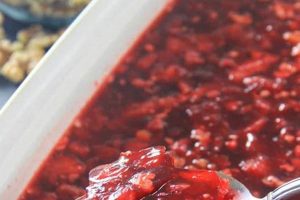A Waldorf salad traditionally features apples, celery, grapes, and walnuts, dressed in mayonnaise. Substituting yogurt for mayonnaise creates a lighter, tangier version, often with fewer calories and less fat. This variation maintains the refreshing crunch and sweetness of the classic while offering a healthier alternative. Typical recipes might also include variations such as dried cranberries, raisins, or different types of nuts.
This healthier take on a classic offers several advantages. The use of yogurt introduces probiotics, beneficial bacteria that support gut health. It also provides a good source of protein and calcium. Furthermore, the lower fat content makes it a suitable option for those following a calorie-restricted or heart-healthy diet. While the original Waldorf salad emerged from the late 19th century at the Waldorf-Astoria Hotel in New York City, the yogurt-based version reflects contemporary preferences for lighter, health-conscious cuisine.
This discussion will further explore various aspects of preparing this dish, including ingredient selection, different yogurt options, and tips for achieving optimal flavor and texture. Variations and serving suggestions will also be considered.
Tips for a Successful Waldorf Salad with Yogurt
Optimizing a Waldorf salad with yogurt involves careful consideration of ingredients and techniques. The following tips offer guidance for achieving a delicious and healthy result.
Tip 1: Apple Selection: Crisp, tart apples such as Granny Smith or Honeycrisp provide the best contrast to the creamy yogurt dressing. Avoid overly sweet or mealy varieties.
Tip 2: Yogurt Choice: Greek yogurt offers a thicker, creamier texture and higher protein content than traditional yogurt. Plain, unflavored yogurt allows for better control over the final sweetness and tanginess.
Tip 3: Enhancing Flavor: A squeeze of lemon juice can brighten the flavors and prevent the apples from browning. A touch of honey or maple syrup can add subtle sweetness if desired.
Tip 4: Nut Variety: While walnuts are traditional, other nuts like pecans, almonds, or cashews can provide interesting flavor variations. Toasted nuts offer enhanced crunch and aroma.
Tip 5: Incorporating Dried Fruit: Dried cranberries, raisins, or chopped apricots add a chewy sweetness and complement the other ingredients. Soaking dried fruit briefly in warm water can plump them and enhance their texture.
Tip 6: Ingredient Preparation: Dice all ingredients into uniform, bite-sized pieces for optimal presentation and ease of eating. Chill the ingredients before combining to ensure a refreshing salad.
Tip 7: Timing is Key: To prevent the salad from becoming watery, dress it just before serving. This maintains the crispness of the apples and the integrity of the yogurt dressing.
By following these tips, one can achieve a Waldorf salad with yogurt that is both flavorful and nutritious. The balance of textures and flavors creates a satisfying and refreshing dish.
These guidelines provide a foundation for culinary exploration and customization. The following section will explore variations and serving suggestions to further enhance enjoyment of this versatile salad.
1. Ingredients
Ingredient selection significantly impacts the final character of a Waldorf salad prepared with yogurt. The interplay of flavors and textures relies on the careful choice and balance of components. For instance, the tartness of Granny Smith apples contrasts with the sweetness of grapes and the creamy tang of yogurt, while the walnuts contribute a satisfying crunch. Substituting red grapes for green, or pecans for walnuts, demonstrably alters the sensory experience. The quality of ingredients also plays a crucial role; using fresh, crisp apples versus mealy ones will affect both taste and texture.
Understanding the role of each ingredient allows for informed substitutions and adjustments to suit individual preferences and dietary needs. Using low-fat yogurt instead of full-fat Greek yogurt reduces the overall calorie and fat content. Individuals with nut allergies can substitute sunflower seeds or pumpkin seeds for walnuts. The sweetness can be adjusted by adding a touch of honey or maple syrup to the yogurt dressing. These choices demonstrate the practical significance of understanding the contribution of each ingredient.
Ultimately, a successful Waldorf salad with yogurt hinges on the thoughtful selection and preparation of its ingredients. This knowledge empowers informed choices that cater to individual tastes and dietary requirements. It facilitates creative variations while preserving the essence of this classic dish. The interplay of flavors and textures forms a dynamic culinary experience that can be tailored through ingredient awareness.
2. Preparation
Preparation significantly influences the quality and enjoyment of a Waldorf salad with yogurt. Careful preparation ensures the optimal texture and flavor profile of the final dish. For instance, chopping the apples and celery into uniform pieces not only enhances presentation but also ensures even distribution of the yogurt dressing. Furthermore, timing is crucial. The salad should be dressed just before serving to prevent the apples from becoming soggy and the yogurt from thinning. Failure to adhere to proper preparation techniques can lead to a less appealing and less palatable resultwatery, unevenly textured salad with compromised flavor. Conversely, meticulous preparation yields a crisp, refreshing salad with a balanced texture and flavor profile.
Specific preparatory steps merit attention. Apples, prone to enzymatic browning, should be tossed with a bit of lemon juice immediately after cutting. This preserves their fresh appearance and bright flavor. Toasted nuts enhance the overall flavor and texture of the salad, and toasting them prior to assembly is recommended. If dried fruit is included, a brief soak in warm water plumps the fruit, adding a more pleasant chewiness. These nuanced preparatory steps highlight the connection between preparation and the ultimate success of the dish. They underscore the attention to detail required for a superior culinary outcome.
In summary, the significance of preparation in creating a successful Waldorf salad with yogurt cannot be overstated. Proper techniques, including timing and ingredient handling, directly impact the final taste, texture, and appearance. Careful preparation elevates this simple dish, transforming it from a basic combination of ingredients into a delightful culinary experience. Neglecting these crucial steps, however, compromises the final product, resulting in a less satisfying outcome. Ultimately, an understanding of these preparatory nuances allows one to fully appreciate and enjoy the potential of this classic salad.
3. Yogurt Selection
Yogurt selection significantly impacts the flavor profile, texture, and nutritional value of a Waldorf salad. The choice of yogurt determines the final dish’s tanginess, creaminess, and overall balance. A full-fat Greek yogurt delivers a rich, decadent texture and a pronounced tang, complementing the sweetness of the fruit and the crunch of the nuts. Conversely, a low-fat or non-fat yogurt creates a lighter, less dense salad, potentially better suited for those seeking a lower-calorie option. Using flavored yogurts, such as vanilla or honey, introduces additional sweetness and can mask the delicate flavors of the other ingredients. Plant-based yogurt alternatives, like coconut or almond yogurt, offer distinct flavor profiles and cater to specific dietary requirements, though they may alter the traditional character of the salad. For example, the thicker consistency of Greek yogurt adds a luxurious mouthfeel while the tartness balances the other components. Using a thin, runny yogurt can result in a watery salad that lacks the desired creamy texture.
The choice of yogurt also affects the nutritional content. Greek yogurt, for example, offers a higher protein content compared to traditional yogurt, contributing to a more satiating meal. Choosing a yogurt with live and active cultures adds probiotics, beneficial bacteria that support gut health. Examining yogurt labels for added sugars is crucial, as some flavored yogurts contain significant amounts of added sugar. This consideration aligns with health-conscious approaches to recipe modification. One might choose a plain, unsweetened yogurt and add a touch of honey or maple syrup for controlled sweetness. This customization allows for both flavor adjustment and management of sugar intake. For instance, individuals monitoring sugar intake might opt for plain, unsweetened yogurt and add a small amount of natural sweetener like honey for controlled sweetness and flavor enhancement.
In conclusion, yogurt selection is a pivotal decision in preparing a Waldorf salad. It directly influences taste, texture, and nutritional value. Careful consideration of these factors ensures a balanced and enjoyable culinary experience, tailored to individual preferences and dietary needs. The interplay between the yogurt and other ingredients creates a dynamic flavor profile, making yogurt selection a critical element in the overall success of the dish. Understanding these nuances empowers informed choices, enhancing both the culinary and nutritional value of this classic salad.
4. Flavor Balance
Flavor balance is paramount in a successful Waldorf salad with yogurt. The dish thrives on the interplay of contrasting yet complementary tastes: the sweetness of the fruit, the tartness of the apple and yogurt, the savory nuttiness, and the creamy texture of the dressing. A harmonious blend of these elements elevates the salad from a simple combination of ingredients to a complex and satisfying culinary experience. Without proper balance, the salad can become overly sweet, excessively tart, or bland.
- Sweetness and Tartness
The interplay between sweetness and tartness forms the foundation of flavor balance in this salad. Tart apples, such as Granny Smith, provide a necessary counterpoint to the sweetness of grapes and any added dried fruit. The tang of the yogurt further enhances this dynamic, preventing the salad from becoming cloyingly sweet. Adjusting the ratio of sweet to tart ingredients allows for customization based on individual preferences. For instance, using sweeter apples like Fuji requires less added sweetener in the yogurt dressing or a smaller quantity of dried fruit.
- Creaminess and Crunch
Textural contrast is equally important. The creamy yogurt dressing provides a smooth backdrop for the crisp crunch of apples, celery, and nuts. This interplay of textures adds another layer of complexity and enjoyment. Toasted nuts offer a more pronounced crunch, further enhancing this contrast. The addition of dried fruit introduces a subtle chewiness, contributing to the overall textural diversity. The creamy yogurt acts as a unifying element, coating the ingredients and delivering a satisfying mouthfeel. Without this creamy element, the salad would lack cohesion and textural depth.
- Savory Notes
While sweetness and tartness dominate, a hint of savory depth elevates the flavor profile. Nuts, especially walnuts or pecans, offer this savory element, adding complexity and preventing the salad from tasting one-dimensional. A pinch of salt in the yogurt dressing further enhances these savory notes, balancing the overall flavor profile. Some recipes incorporate a small amount of Dijon mustard into the yogurt dressing, adding another layer of savory complexity. This nuanced addition underscores the importance of balancing sweet, tart, and savory elements for a truly satisfying flavor experience.
- The Role of Acidity
Acidity plays a crucial role in brightening the flavors and balancing the sweetness. A squeeze of lemon juice in the yogurt dressing not only prevents enzymatic browning of the apples but also adds a refreshing zing. This acidity also helps to cut through the richness of the yogurt, creating a more balanced and refreshing flavor profile. Additionally, the acidity enhances the perception of sweetness, allowing for a more nuanced and complex flavor experience. For instance, the acidity highlights the natural sweetness of the grapes and dried fruit without making the salad taste overly sweet. This delicate interplay demonstrates the importance of acidity in achieving overall flavor balance.
A well-balanced Waldorf salad with yogurt offers a delightful interplay of sweet, tart, creamy, crunchy, and savory elements. Achieving this balance requires careful consideration of ingredient selection, preparation, and the proportions in which they are combined. The final result is a refreshing and satisfying salad that showcases the harmonious blend of contrasting flavors and textures. The synergy of these elements elevates the dish beyond its individual components, creating a cohesive and enjoyable culinary experience.
5. Health Benefits
The health benefits associated with a Waldorf salad made with yogurt stem primarily from the nutritional value of its individual components and the substitution of yogurt for traditional mayonnaise. This shift results in a lighter dish with reduced fat and calories, making it a suitable option for those managing weight or cholesterol levels. The yogurt itself contributes probiotics, beneficial bacteria known to support gut health and improve digestion. Regular probiotic intake may enhance the gut microbiome, potentially reducing the risk of certain digestive disorders. Furthermore, yogurt provides calcium and protein, essential nutrients for bone health and muscle maintenance, respectively.
The inclusion of fruits and nuts further amplifies the nutritional value. Apples offer dietary fiber, promoting satiety and aiding digestive regularity. They also contribute antioxidants, which protect cells from damage caused by free radicals. Grapes, another source of antioxidants, provide additional vitamins and minerals. Walnuts, rich in omega-3 fatty acids, contribute to heart health and cognitive function. The combined nutritional benefits of these ingredients create a dish that supports overall well-being. For example, substituting Greek yogurt for regular yogurt increases the protein content, contributing to greater satiety and potentially aiding in weight management efforts. Selecting a variety of colorful grapes maximizes the intake of diverse antioxidants. Incorporating a mix of nuts and seeds further diversifies the nutrient profile.
In summary, a Waldorf salad with yogurt offers a range of health benefits due to its nutrient-rich ingredients and the healthier dressing choice. From promoting gut health and supporting heart function to providing essential vitamins, minerals, and antioxidants, this dish presents a nutritious and flavorful option. Understanding these benefits reinforces the value of incorporating this salad into a balanced diet. However, individual dietary needs and potential allergies should always be considered. While the recipe inherently offers numerous health advantages, tailoring ingredient choices based on individual requirements optimizes these benefits. This customization allows individuals to maximize the nutritional value while accommodating specific dietary restrictions or preferences.
6. Serving Suggestions
Serving suggestions significantly enhance the versatility and enjoyment of a Waldorf salad prepared with yogurt. Thoughtful presentation and pairings elevate this dish beyond a simple side salad, transforming it into a more substantial and satisfying meal component or a standalone light lunch. Understanding these serving suggestions allows for greater culinary flexibility and appreciation of the dish’s potential. For example, serving the salad on a bed of crisp lettuce adds visual appeal and textural contrast. Garnishing with fresh herbs, such as chopped chives or parsley, introduces a burst of fresh flavor and visual interest. These seemingly small details elevate the dining experience, demonstrating the impact of thoughtful presentation.
The Waldorf salad with yogurt lends itself to a variety of pairings. It complements grilled chicken or fish, adding a refreshing counterpoint to richer protein sources. It can also be served alongside sandwiches or wraps, providing a lighter, healthier alternative to traditional sides like chips or fries. Furthermore, the salad can be used as a filling for wraps or sandwiches, offering a portable and convenient lunch option. Scooping the salad onto endive leaves or cucumber slices creates elegant appetizers, suitable for more formal occasions. These diverse applications demonstrate the adaptability of the salad and its potential to enhance various meal formats. For instance, serving the salad with grilled salmon offers a balanced meal combining protein, healthy fats, and fresh produce. Using the salad as a sandwich filling provides a nutritious and flavorful lunch option. These practical examples illustrate how serving suggestions can transform a simple salad into a versatile culinary component.
In conclusion, serving suggestions expand the culinary possibilities of a Waldorf salad with yogurt. Creative presentation and strategic pairings elevate the dish, enhancing its visual appeal and broadening its application within various meal contexts. Understanding these serving suggestions allows for a deeper appreciation of the salad’s adaptability and its potential to contribute to a more diverse and satisfying dining experience. From simple garnishes to more elaborate pairings, these suggestions empower individuals to transform a basic salad into a versatile and enjoyable culinary creation. This understanding ultimately enhances the overall culinary experience, showcasing the potential of this classic dish in diverse settings.
7. Variations
Variations on the classic Waldorf salad with yogurt recipe demonstrate the dish’s adaptability and offer opportunities for culinary exploration. These modifications can cater to individual preferences, dietary restrictions, seasonal ingredient availability, and creative impulses. Understanding the potential variations expands the culinary possibilities and enhances appreciation for the dish’s versatility.
- Fruit Selection
While grapes and apples are traditional, other fruits can add unique dimensions to the salad. Dried cranberries or cherries introduce tart sweetness and chewy texture. Diced pears or segments of oranges provide alternative sources of sweetness and moisture. Seasonal fruits, such as berries in the summer or pomegranate seeds in the fall, align the salad with seasonal flavors. These variations demonstrate the adaptability of the basic recipe and its capacity to incorporate a wide range of fruit flavors and textures.
- Nut and Seed Options
Walnuts are customary, but other nuts and seeds offer compelling alternatives. Pecans provide a buttery richness, while toasted almonds introduce a delicate crunch. Sunflower seeds or pumpkin seeds offer nut-free options for those with allergies, while also contributing healthy fats and distinct flavors. Experimenting with different nuts and seeds alters the flavor profile and textural complexity of the salad. For example, using pecans instead of walnuts creates a richer, more decadent flavor profile, while sunflower seeds introduce a lighter, nuttier taste and a slightly different textural element.
- Dressing Enhancements
The yogurt base provides a blank canvas for flavor experimentation within the dressing. Incorporating a touch of honey or maple syrup enhances sweetness. A squeeze of lemon or orange juice brightens the flavors and adds acidity. A dash of cinnamon or nutmeg introduces warm spice notes, particularly complementary during colder months. A small amount of Dijon mustard adds a subtle tang. These variations demonstrate how the basic yogurt dressing can be transformed to complement different flavor profiles and seasonal ingredients.
- Savory Additions
While traditionally a sweet and savory salad, the Waldorf salad with yogurt can embrace more pronounced savory elements. Crumbled bacon or diced cooked chicken add protein and savory depth. Chopped fresh herbs, such as chives or parsley, introduce fresh, herbaceous notes. These additions transform the salad into a more substantial meal, expanding its versatility beyond a side dish or light lunch. For instance, adding grilled chicken or shrimp elevates the salad to a complete protein-rich meal. Incorporating crumbled blue cheese introduces a pungent, savory element that complements the sweetness of the fruit.
These variations highlight the adaptability of the Waldorf salad with yogurt, allowing it to evolve beyond its traditional form while retaining its essential character. By exploring these modifications, individuals can personalize the recipe to suit specific tastes and dietary needs, creating unique culinary experiences grounded in a classic foundation. This inherent flexibility ensures the enduring appeal of the Waldorf salad, allowing it to remain a relevant and enjoyable dish across diverse culinary landscapes.
Frequently Asked Questions
This section addresses common inquiries regarding the preparation and enjoyment of Waldorf salad with yogurt.
Question 1: Can this salad be prepared in advance?
While the individual components can be prepared ahead of time, it is recommended to combine the salad just prior to serving. This prevents the apples from oxidizing and the yogurt dressing from thinning, ensuring optimal texture and flavor.
Question 2: What type of yogurt is best suited for this salad?
Greek yogurt is generally preferred for its thick, creamy texture and higher protein content. Plain, unflavored yogurt allows for better control over sweetness and tanginess. However, low-fat or non-fat yogurt can be substituted for a lighter version.
Question 3: How can browning of the apples be prevented?
Tossing the diced apples with a small amount of lemon juice immediately after cutting inhibits enzymatic browning and preserves their fresh appearance and flavor.
Question 4: What are suitable nut substitutions for those with allergies?
Sunflower seeds, pumpkin seeds, or pepitas offer viable alternatives to walnuts for individuals with nut allergies. These options provide a similar textural element and contribute healthy fats.
Question 5: Can dried fruit be incorporated into the salad?
Dried cranberries, raisins, or chopped apricots complement the other ingredients. Soaking the dried fruit briefly in warm water before adding them to the salad plumps them, enhancing their texture and flavor.
Question 6: How can the sweetness of the salad be adjusted?
The sweetness can be adjusted by adding a small amount of honey or maple syrup to the yogurt dressing. The amount added can be tailored to individual preference.
Addressing these common questions clarifies key aspects of preparing and enjoying a Waldorf salad with yogurt, enabling informed choices and enhancing the overall culinary experience.
The following section will delve into specific recipe variations and offer further customization ideas.
Recipe Waldorf Salad with Yogurt
Exploration of the yogurt-based Waldorf salad reveals a dish adaptable to various tastes and dietary needs. From ingredient selection and preparation techniques to flavor balancing and serving suggestions, the recipe offers significant flexibility. The substitution of yogurt for mayonnaise yields a healthier alternative to the classic preparation, while retaining the essential characteristics of the dish. Key considerations include apple selection for optimal tartness, yogurt choice for desired texture and richness, and the incorporation of nuts and dried fruits for added flavor and texture. Proper preparation techniques, such as preventing apple oxidation and timing the dressing addition, ensure a successful outcome. Variations involving alternative fruits, nuts, and flavor enhancements within the yogurt dressing allow for personalization and culinary creativity.
The Waldorf salad with yogurt represents a compelling intersection of culinary tradition and contemporary health consciousness. Its adaptability ensures continued relevance within evolving dietary landscapes. Further exploration of flavor profiles and ingredient combinations offers continued potential for culinary innovation. Ultimately, an informed approach to ingredient selection, preparation, and presentation elevates this seemingly simple salad to a versatile and satisfying culinary experience.






